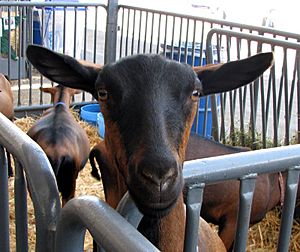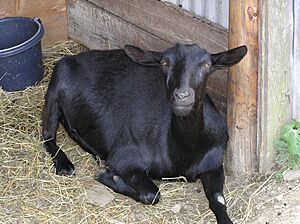Oberhasli goat facts for kids
 |
|
| Other names | Swiss Alpine |
|---|---|
| Country of origin | Originated in the Swiss Alps. Brought over to United States in 1900s. |
| Standard | ADGA/AGS |
| Use | milk |
Quick facts for kids Traits |
|
| Weight |
|
| Height |
|
| Wool color | chamoisée, brown with black dorsal stripe and lower legs |
| Face color | brown with black stripes |
| Horn status | horned or polled |
| Notes | |
| Website: Oberhasli Breeders of America | |
|
|
The Oberhasli is a type of dairy goat from the United States. It originally came from a region in central Switzerland called the Oberhasli district. These goats were known as "Chamois Colored Goats" because of their fur color.
All purebred Oberhasli goats today come from just five goats brought to the U.S. in 1936. A group of people who raise these goats formed an association in 1977. Before that, these goats were often called Swiss Alpine goats and sometimes bred with other types of Alpine goats.
Contents
History of the Oberhasli Goat
Goats similar to the Oberhasli were first brought to the USA in 1906 and 1920. However, these goats were not kept as a separate breed, and their family lines were lost.
How the Breed Started
In 1936, a person named H. O. Pence brought five Chamois Colored Goats from Switzerland to the U.S. All purebred Oberhasli goats in the USA today are descendants of these five animals.
Until the 1970s, these goats were registered as "Swiss Alpines." If they were mixed with French Alpine or American Alpine goats, they were called "American Alpines."
Becoming an Official Breed
Around 1977, a group called the Oberhasli Breeders of America was formed. In 1978 or 1979, the Oberhasli was officially recognized as its own breed by the American Dairy Goat Association (ADGA).
A breeder named Esther Oman in California kept careful records of her purebred Oberhasli goats. Her herd became the main foundation for the new breed. In 1980, the ADGA also added goats that were part-Oberhasli to the new breed's records.
What Oberhasli Goats Look Like
The American Dairy Goat Association and the American Goat Society have rules for what an Oberhasli goat should look like.
Coat Color and Markings
The special coloring of the Oberhasli breed is called "chamoisée" or "chamoisee." This name comes from the wild Alpine chamois, an animal whose colors are similar.
Their coat is usually a bay or medium brown color. They have distinct black markings, which include:
- Two black stripes on their face, running from their eyes to their nose.
- A black forehead.
- A black stripe along their back.
- Black on their belly and lower legs.
Interestingly, only female Oberhasli goats (does) can be solid black. Male goats (bucks) must have the chamoisée coloring.
Milk Production
Oberhasli goats are known for being good dairy goats. The record for milk production from one Oberhasli goat during a single lactation period (when they produce milk) is 2,116 kg (4,665 lb).



